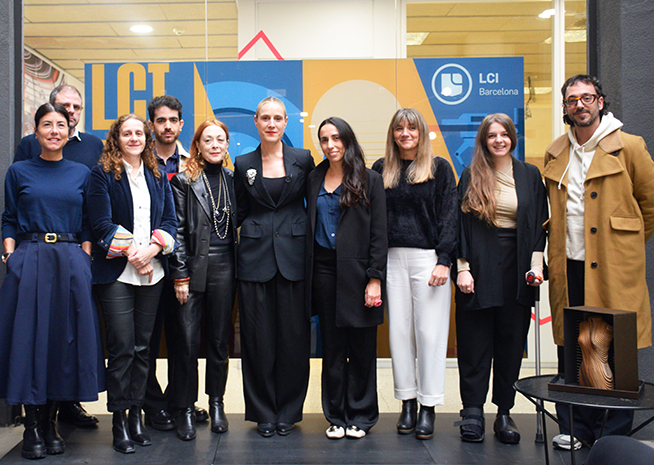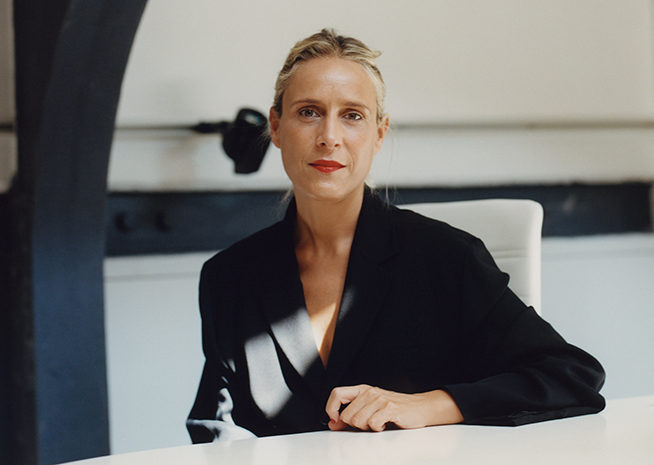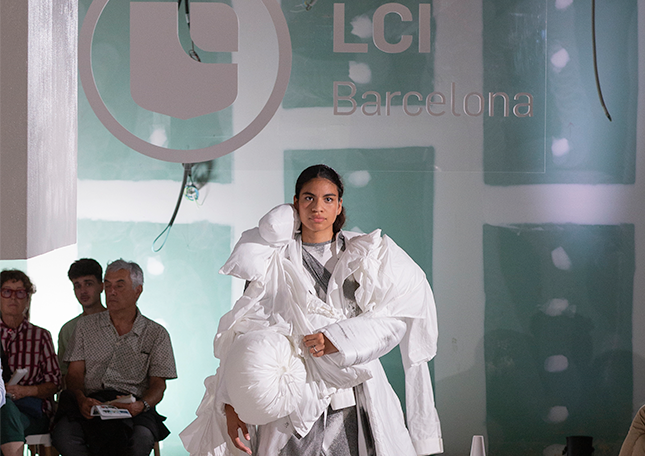Professor Mariano Espinosa participates in a short film awarded by the Cannes Festival
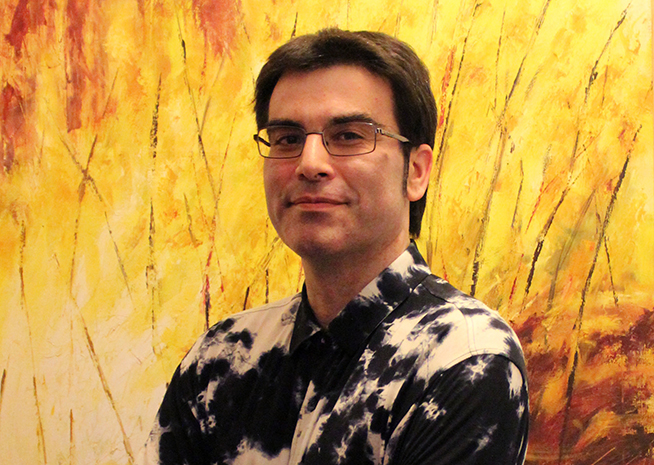
Alegrías riojanas, a short film directed by filmmaker César Velasco Broca, features our Fashion area professor Mariano Espinosa as a conceptual artist. Last July, the Cannes Film Festival awarded them with the Focus WiP (Work in Progress), a recognition designed so that the most interesting short films in production or post-production on the current scene can be finished and launched internationally.
We spoke to Mariano and this is what he told us:
- How did your participation in Alegrías riojanas come about?
It is another collaboration with its director, César Velasco Broca. We've known each other since high school. Before entering university, we started directing a comic and poetry fanzine with another friend. That's when we started to work in tandem: he writing and me drawing some short comics. Later, during his degree, he asked me to draw the storyboard and poster for his first short film. It was a very strange story but a lot of fun to draw. I did it in two afternoons with tiny, synthetic drawings, but according to him I told it exactly as I had it in my head and, in fact, this short film (Kinky Hoodoo Voodoo) is exactly as I drew it.
Later I continued drawing storyboards and/or concept art for many of his projects, some of which were completed (La costra láctea, Nuestra amiga la luna, Alegrías riojanas) and others that remained in the pipeline (Hey you Mary Lou or the feature films Noches transarmónicas and Imperio y Aurora). I also illustrated his collection of poems Un piso en propiedad. So it was only natural that he got in touch with me to set up the project Alegrías riojanas. It also so happened that I was caught up in reading Dante's The Divine Comedy, so (curious synchronicity) when he told me that his new film was largely set in a medieval purgatory, I jumped at the chance.
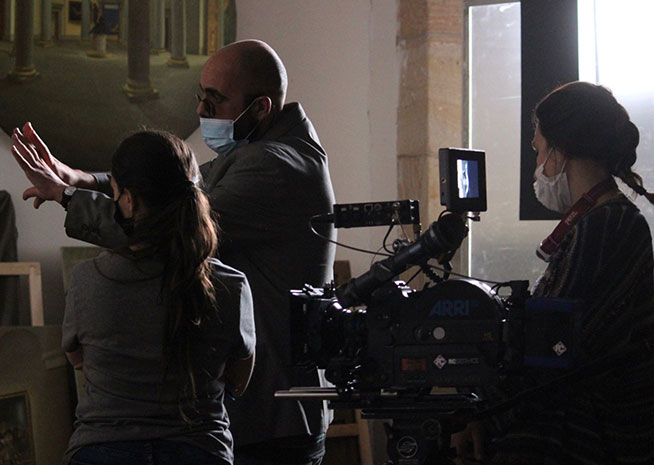
Proto from the filming (Source: La Rioja Film Commission)
- What has your work as a conceptual artist for the short film been about?
Well, there have been several functions. First, visualizing characters; then, making the concept art; and, finally, some extra graphic work such as recreating/restoring cartoons from classic Bruguera comics for a scene that will finally be discarded. I have a folder with more than 60 sheets full of drawings of the project. Of all that I have listed, the concept art has taken the biggest part and, in fact, in the credits I will finally appear as the concept artist. There are 57 drawings that define a major part of the short film and part of what would be its continuation, either in a feature film or in another short film.
The truth is that it has turned out to be a hybrid between concept art and storyboard: too many drawings for concept art but not enough for a storyboard; some not quite finished for concept but all much more finished than what corresponds to a film storyboard. Another characteristic in which it differs from classic concept art is that they are entirely done in pencil and in black and white, which fits very well with the atmosphere of this film, also shot in black and white. Some of the drawings have a hint of color, which will hopefully appear in the corresponding scenes of the film once the color grading and post-production are finished.
I have to say that working with César is very easy for me because I know his world perfectly well and he knows my characteristics and strong points. He is very clear about his visual ideas and, many times, I just visualize on paper what he has in his head.

Mariano's illustrations combine concept art and storyboard
Alegrías riojanas is a short fiction film that combines many genres. How did you manage to capture them all in your work?
Well, it's difficult to define the genre of the film. It brings together tropes from fantasy, science fiction, even noir... but it is integrated into a whole that goes beyond these genres, and perhaps has more to do with the "surrealism" of Buñuel or Lynch (and I say it like that so that we understand each other). Surely César wouldn't define it like that, his great reference is Robert Bresson. In any case, I can tell you that, if we manage to shoot the sequel later, retro science fiction would predominate and even a touch of horror would be added. I have already finished some drawings.
Certainly, this variety of tones requires versatility, always within the realistic approach of the drawing, as it is something that will later be photographed. The connection I have with César, with diverse but shared interests, has helped me a lot when it comes to successfully carrying out the work, and it's always an extra motivation to draw things that you find interesting and fun to capture. We share a lot of cinematographic and literary references, and we drink from the same comics. That helps me to share his enthusiasm for the filmic environment he is developing in all its nuances. It also helps, of course, with all the graphic references that César brings. He's as much a production designer as I am, even though I'm the handyman who gives it shape. And it also contributes to the fact that, although genres are mixed, the atmosphere and the chiaroscuro of the film have a certain unity.
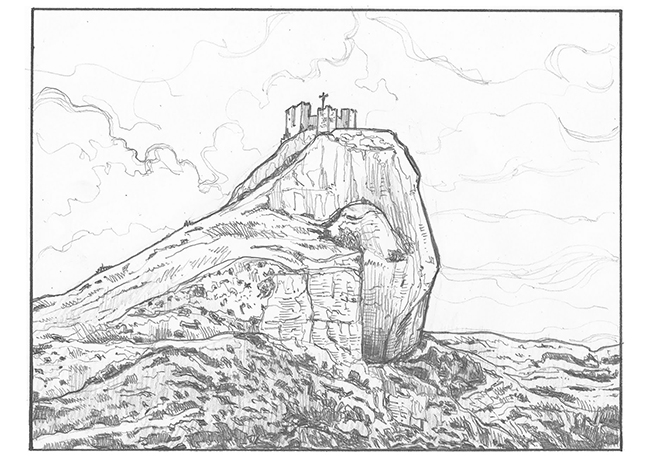
One of the landscapes drawn by our professor
The short film was shot almost entirely in different parts of La Rioja. Did you take the location into account when creating the concept art, the storyboard, etc.? In what way?
Absolutely. Velasco Broca's films are closely linked to the locations, and it is often these locations that provide him with the inspiration to generate stories that develop in them. Therefore, César had already decided on and photographed most of the locations. In many drawings I use these photographs as a reference to draw the environment, while I draw the characters completely from memory. This has made it much easier for me to do a more precise job.
When César didn't have the location decided, especially in the interiors, I looked for photos that gave me a rough idea of what he would like the place to look like. The director is very much in charge of how he wants the visual result, but with the level of understanding we have, this is not a disadvantage, but an advantage for me.
In an audiovisual project like this, does the production design evolve as the filming progresses or is it something unalterable?
It evolves. Many parts are remaining very true to my drawings, but there are always changes. On the one hand, you must consider that I did all the graphic work just after the script was written, and before the costume design or art direction came in, which always contribute things. And, on the other hand, we have worked with a ridiculous budget, about 45,000 euros for a medium-length film that will last between 30 and 40 minutes and contains some special effects and various creatures and aliens that are not cheap to make physically. This means that sometimes things must be changed to stay within the budget.
Regarding the character visualization, several of the final actors are not the ones I drew, the design of an "alien" had to be changed because the original design was prohibitive, and the costumes have also changed. But as far as the concept art is concerned, I must admit that it has been very faithful to my drawings, especially in the exteriors. Even so, some interior designs have been changed, in several sequences the camera position is different and there are some scenes that have been deleted and others that have been added. The latter is often decided by the director during filming or editing. For him, projects are something alive and in continuous transformation and, although he has a precise guide, it is never closed and is always open to change.
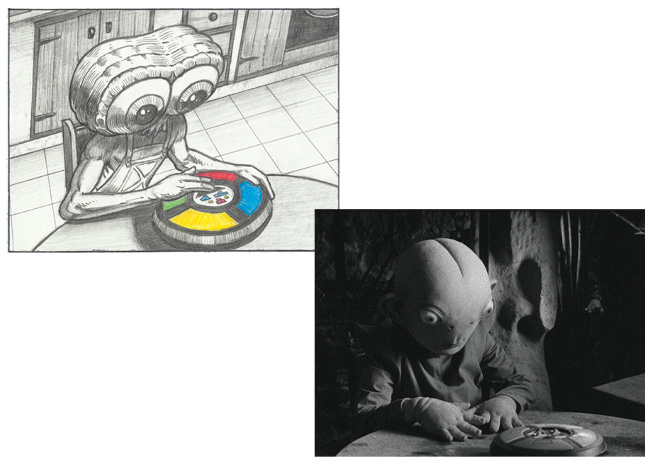
The alien design has been one of the challenges of the project
Tell us about the relationship between you and Velasco Broca on this occasion when it came to bringing the story and its characters to life.
He always gives me to read the script first and then we meet to look for graphic references and make the first sketches. As for the characters, being such a heterogeneous project, they come from a wide variety of backgrounds. The devil had already appeared in Nuevo Altar, his previous short film; the alien was originally a design I made for the discarded project Noches transarmónicas; the medieval soldiers were originally given uniforms taken from Anthony Mann's El Cid (although in the end their uniforms came from a Riojan association that collected medieval and renaissance paraphernalia); for the hermit the reference was Buñuel's Simón del desierto, or one of the contemporary characters was an imitator of Camilo Sesto who lives in Logroño (and whom, unfortunately, the director was unable to convince in the end to take part in the casting). For the drawings we started from some very marked references that later evolved. Regarding the scenes of the story, while César explains them to me, I always do some sketches with him first with the composition and then at home, based on those sketches and the graphic references that we choose for each sequence, I draw them in detail.
I worked on two rounds of drawings: when the project started in September 2018, I did the visualization of the characters and the major part of the concept art for the short film. And a year later, in October 2019, some more concept and character art for the short film and a few drawings that expanded the story to try to turn it into a feature film. Finally, funding was obtained for the short film but not for the feature film and, after half a year of delays due to COVID, it was shot in September 2020 and spring 2021. A first version of almost 30 minutes will be finished by mid-September. We will see if this is the final version or if it will be extended with some more scenes. I think it's after 30 minutes that it's considered a medium-length film, so it's on the border between the two formats.
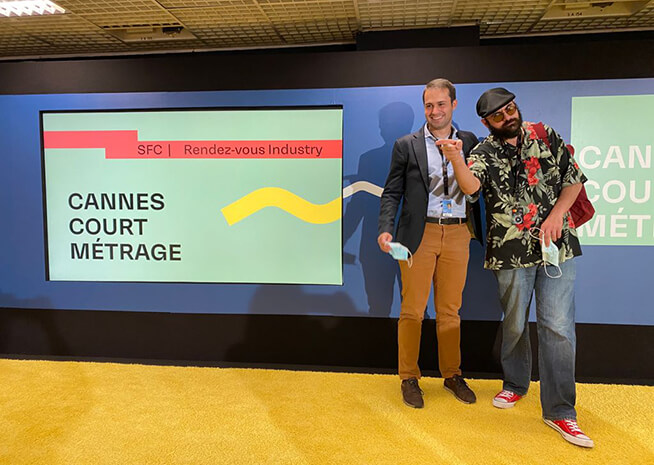
Director César Velasco Broca during his visit to Cannes
- The Cannes Film Festival has awarded you with the Focus WiP. What does this support mean for the team of the short film in a filming conditioned by the restrictions of the pandemic?
Well, it's a window of opportunity and visibility for the project. When it was presented at Cannes, with a trailer and a dossier that included all my drawings, it was the project that was most liked and that's how we were awarded. It has not yet materialized financially, but we are confident that it will. Because, as you point out, the restrictions of the pandemic made filming difficult and contributed to the budget running out without filming some scenes, which, if we can add them, will optimize the result. Now the aim is that, once the film is finished, it can also be premiered in Cannes (it's not that easy, none of the five previous Focus WiPs have been premiered there) and that the interest generated will help to facilitate the financing of César Velasco Broca's future projects.
- And finally, we focus exclusively on you. Explain to us what meaning you give to the fine arts and how they define your vision of the world.
Well, what a leap you've just made! It's a question I would answer differently depending on the moment in my life. It's not the same when I finished my degree and survived for a few years on painting, mainly based on prizes and grants, as it is now that I've been teaching full-time and my pictorial work has been on hold for years, although I don't stop drawing. I have the feeling that when you have practiced an artistic discipline and have tried to develop (with greater or lesser success) a work with a new and different style, you value not only the pragmatic and utilitarian, but also the artistic, the beautiful, and you develop not only the technical and aesthetic, but also lateral thinking and a certain creative intuition.
Something I notice in the new generations is that they have an innate talent for aesthetics but find it harder to be creative, to understand and play with the concepts that form the backbone of aesthetics and whose understanding is necessary to make it evolve. Or maybe it's simply that the new technological tools and an increasingly visual education accentuate this dichotomy that has always been there.

Self-portrait by Mariano Espinosa
Don't miss our professor's website to learn more about him and his work.

